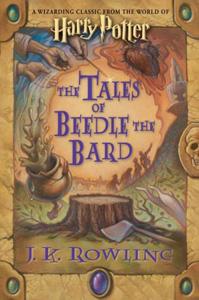I’m going to assume that you (and everyone you’ve ever met) have read the Harry Potter books, so pardon me if the post is light on real backstory. (If you haven’t read them, here’s a summary: Hannah Montana is orphaned and moves to the northwest where she’s seduced by a vampire who takes her to a magical candy factory where she fights a mouse with big ears. Ok? Glad we got that straightened out.)
I just finished The Tales of Beedle the Bard. I have a few things to say, the first of which is not only is J.K. Rowling witty and smart and charitable, she’s also not a bad illustrator. And I admit I have a nerd-on for her that just won’t quit. She’s got that “confident, intelligent, talented woman with an accent” thing, plus she sometimes wears high heels with straps that look like gold snakes. Whoooo petrificus totalis!
 But I’ll stop that line of thought now, as this isn’t really intended to be an episode of “Most Shaggable Novelists.” (Feel free to mention your nominees in the comments.)
But I’ll stop that line of thought now, as this isn’t really intended to be an episode of “Most Shaggable Novelists.” (Feel free to mention your nominees in the comments.)
When I first heard of the Tales—initially written for a few friends and then later sold for children’s charities—I wondered how seriously she’d taken it. Would it be as thoughtful as the rest of her work, or just plain silly, or a self-parody along the lines of the Sherlock Holmes story Doyle wrote for the library in then-Princess Elizabeth’s dollhouse? I sincerely hoped she wasn’t becoming the sort opportunist author who figures she could sign a phonebook and people would buy it. (Even if there are many such readers, myself included. If she autographed a phonebook for me, I’d not only buy it, I’d probably lick it. But I digress.)
I think she did a commendable job. The book is mostly lighthearted and amusing, but it wasn’t simply thrown together. While it doesn’t provide anything that Harry Potter readers must know, there’s plenty that’s fun to know. The format of the book is itself entertaining: the stories, we’re told, have been translated by Hermione Granger and contain footnotes from J.K. Rowling as a sort of guest editor on Muggle matters, and best of all, notes on each story from the illustrious Albus Percival Wulfric Brian Dumbledore. (Brian is a wonderfully silly middle name for him, isn’t it? It’s almost as silly a name as Gilbert Keith Chesterton. I mean, really Gilbert Keith? What kind of combo is that? How many cacophonic pairs did Mr. and Mrs. Chesterton go through? “Let’s see Jacques Bubba? No. Raphael Kevin? Getting closer Ernie Nergal Chesterton? Wait Gilbert Keith yes!”)
More than the fables themselves, Dumbledore’s commentary is what intrigued me when I first heard about the book. Which Dumbledore would we find? The goofy Dumbledore who dreams of warm socks, enjoys knitting patterns and says: “I would like to say a few words. And here they are: Nitwit! Blubber! Oddment! Tweak!” or the philosophical adventurer who says, “To the well-organized mind, death is but the next great adventure”? Would it be the arrogant wizard who deliberately put young people in harm’s way, or the self-torturing and secretive idealist revealed in the last two books? Of course, all these are refractions from the prism of his character. Dumbledore is one of the most emotionally complicated characters in the seven books (exceeded, perhaps, by Severus “De Bergerac” Snape).
 What I’ve found pleasantly surprised me. Seen for the first and only time outside the danger and the drama of the seven books, this is Dumbledore without ulterior motives (with one exception, noted later), without schemes, but retaining the usual wit and perception, providing anecdotes and social commentary (especially on Muggle relations, as you’d expect). I imagine this as a side project written by Dumbledore on rainy afternoons, alone in his rooms, reflecting on stories that have been with him since childhood.
What I’ve found pleasantly surprised me. Seen for the first and only time outside the danger and the drama of the seven books, this is Dumbledore without ulterior motives (with one exception, noted later), without schemes, but retaining the usual wit and perception, providing anecdotes and social commentary (especially on Muggle relations, as you’d expect). I imagine this as a side project written by Dumbledore on rainy afternoons, alone in his rooms, reflecting on stories that have been with him since childhood.
As for the stories themselves, my favorite by far is “The Hairy Heart,” the darkest of the bunch. It speaks of a man who seeks to avoid the weakness of love and his heart becomes something literally monstrous in the process. “Babbity Rabbity and her Cackling Stump” is another gem—a variation on “The Emperor’s New Clothes.”
In the commentary on “The Tale of the Three Brothers”—the story most directly linked to Harry Potter and the Deathly Hallows—we see the only clear evidence, in this book, of Dumbledore being deceptive, in his dismissive claims that the wand, cloak and stone don’t exist. It would be obvious to anyone who has read The Deathly Hallows that Dumbledore knew perfectly well that the story of the Peverell brothers had not been a total fabrication, and not only did he believe in the hallows, all three had been in his possession at one time or another.
Knowing that Dumbledore is lying here, I can’t help but smile, imagining him bullshitting a not-yet-existent audience, with the peculiar mixture of arrogance and caution that makes him so much fun to read.
I couldn’t say, as I am not at all objective, if the book would be of any interest to a non-Potter fan. I suspect not. But for those of us who love the world Rowling created, while nothing will ever really satisfy the hunger for more books (which we know aren’t coming), it makes a lovely dessert.










